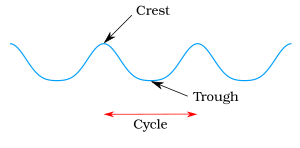Crest and trough facts for kids
Imagine a wave moving across water, like ripples in a pond or ocean waves. The highest point of that wave is called a crest. It's like the very top of a hill on the wave. On the other hand, the lowest point of the wave, like the bottom of a valley, is called a trough.
Crests and troughs are important parts of all kinds of waves, not just water waves. This includes sound waves, light waves, and even electromagnetic waves like radio signals.
Contents
Understanding Wave Parts
Waves are a way that energy moves from one place to another. They often have a repeating pattern.
What is a Crest?
A crest is the point on a wave where the material it's moving through is pushed up the most. Think of a rope you are shaking up and down. When the rope goes as high as it can, that's a crest. It's the peak of the wave.
What is a Trough?
A trough is the exact opposite of a crest. It's the point where the material is pulled down the most. If you're still imagining that rope, when it goes as low as it can, that's a trough. It's the lowest part of the wave.
How Waves Interact: Interference
Sometimes, two or more waves meet each other. When they do, they can combine in interesting ways. This is called wave interference.
Constructive Interference
When the crests of two waves meet up, they can add together to make an even bigger crest. This is like two hills combining to make a super hill! This is called constructive interference. The waves work together to make a stronger wave. This also happens when two troughs meet, making a deeper trough.
Destructive Interference
What happens if a crest from one wave meets a trough from another wave? If they are the same size, they can cancel each other out! This is called destructive interference. It's like a hill filling up a valley, making the surface flat. The waves seem to disappear, and the water (or whatever the wave is moving through) becomes still.
Why are Crests and Troughs Important?
Understanding crests and troughs helps scientists and engineers study and use waves. For example, knowing about wave interference is key to designing things like noise-canceling headphones or understanding how radio signals work. They are fundamental parts of how we describe and measure waves in physics.
See also
 In Spanish: Cresta (ola) para niños
In Spanish: Cresta (ola) para niños


